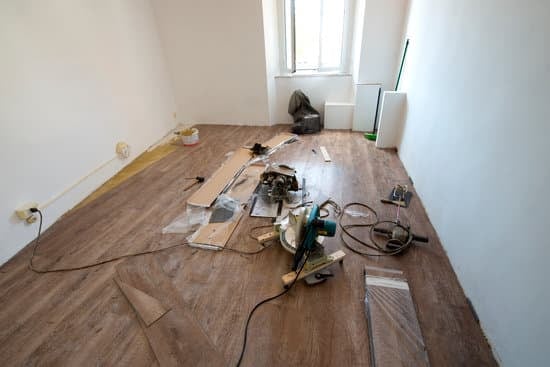When it comes to home improvement projects, many homeowners are not aware of the potential tax benefits that can accompany their renovations. Claiming home improvement expenses on your taxes can provide you with significant savings and even help offset the costs of your upgrades. Whether you’re planning a simple repair or a major renovation, understanding how these expenses can impact your taxes is essential.
Knowing the difference between home repairs and home improvements is the first step in determining what expenses may be eligible for tax deductions. While repairs generally maintain the existing condition of your property, improvements enhance its value, efficiency, or adaptability. From installing energy-efficient appliances to adding a new bathroom, there are various types of projects that may qualify for tax deductions.
To claim home improvement expenses on your taxes, certain criteria must be met. Knowing these requirements and understanding what documentation is needed is crucial to ensure you maximize your deductions. Additionally, keeping accurate records throughout the process will make claiming your expenses easier when tax season arrives.
In this article, we will delve into the different aspects of claiming home improvement expenses on taxes. We will explore the types of projects that qualify for deductions and outline the necessary criteria for eligibility. Additionally, we will discuss the importance of proper documentation and record-keeping and highlight common mistakes to avoid. By understanding these key factors, you can navigate through the tax deduction process confidently and potentially enjoy significant savings on your home improvement projects.
The Importance of Knowing the Difference Between Home Repairs and Home Improvements
When it comes to claiming home improvement expenses on taxes, one crucial aspect to understand is the difference between home repairs and home improvements. While both may involve making changes or upgrades to your property, they are treated differently from a tax perspective. Knowing this distinction can help you determine what expenses can be claimed and potentially save you money.
Understanding Home Repairs
Home repairs refer to any work done to fix damages or deterioration in your property. This includes tasks such as fixing a leaky roof, repairing a broken window, or replacing a malfunctioning heater. In general, home repairs are considered necessary maintenance to keep your property in good condition.
From a tax perspective, home repairs cannot be claimed as deductions on your taxes. The IRS does not consider them as capital improvements that increase the value of your property. Instead, these expenses are viewed as regular expenses that all homeowners face over time.
Exploring Home Improvements
On the other hand, home improvements involve making changes to your property that go beyond simple repairs and increase its value or prolong its useful life. These projects tend to be more substantial and transformative in nature, such as adding a room, renovating a kitchen, or installing solar panels.
Unlike home repairs, some home improvement expenses may qualify for tax deductions. However, there are specific criteria that must be met for these deductions to apply. Typically, the improvements must meet certain energy efficiency standards or accommodate medical needs for individuals with disabilities. It’s important to consult with a tax professional or refer to IRS guidelines to ensure your specific project qualifies for deductions.
Understanding the difference between home repairs and home improvements is essential for maximizing potential tax benefits when it comes to claiming expenses on your taxes. By properly categorizing your project and meeting the necessary criteria set forth by the IRS, you can make sure you’re accurately reporting deductible expenses and potentially save money in the process.
Exploring the Types of Home Improvement Projects That Qualify for Tax Deductions
When it comes to claiming home improvement expenses on taxes, it is important to understand which types of projects are eligible for tax deductions. Not all home improvement projects qualify for this benefit, so knowing the criteria can help homeowners maximize their tax savings.
Energy-Efficiency Upgrades
One type of home improvement project that often qualifies for tax deductions is energy-efficient upgrades. These upgrades focus on improving the energy efficiency of the home, such as installing solar panels, upgrading to energy-efficient windows and doors, or replacing old appliances with Energy Star-rated ones. The government provides incentives for these types of improvements in order to promote sustainability and reduce environmental impact.
Medical Necessity Modifications
Home improvement projects that are necessary for medical reasons may also qualify for tax deductions. This could include modifications like installing wheelchair ramps, widening doorways for accessibility, or adding handrails or grab bars in bathrooms. In order to claim these deductions, homeowners typically need a doctor’s note stating that the modifications are medically necessary.
Capital Improvements
Capital improvements are another category of home improvement projects that may be eligible for tax deductions. These improvements increase the value of the home and can include renovations like adding a new room or an additional bathroom, replacing the roof, or upgrading the kitchen. It’s important to note that routine repairs and maintenance do not fall under this category and do not qualify for tax deductions.
By understanding which types of home improvement projects qualify for tax deductions, homeowners can make informed decisions about their renovation plans. It’s crucial to keep in mind that specific rules and regulations may vary depending on your location and individual circumstances. Consulting with a tax professional or accountant can provide you with further guidance on maximizing your potential tax savings through home improvements.
Understanding the Criteria for Claiming Home Improvement Expenses on Taxes
To qualify for tax deductions, home improvement expenses must meet certain criteria. Understanding these criteria is essential to ensure that you can claim the expenses on your taxes accurately.
One of the main criteria for claiming home improvement expenses on taxes is that the project must be considered a “capital improvement.” Capital improvements are those that add value to your home or extend its useful life. Examples include adding a new room, installing a new roof, or upgrading your heating and cooling systems. On the other hand, regular repairs and maintenance tasks, such as fixing leaks or repainting walls, do not qualify as capital improvements and cannot be claimed.
Another important criterion is that the home improvement must be made to your primary residence. Expenses incurred for improving a rental property or a second home are not eligible for tax deductions. Additionally, if you use part of your primary residence for business purposes, you may only claim the portion of the expenses related to personal use.
It’s also worth noting that timing plays a role in claiming home improvement expenses on taxes. The IRS requires you to subtract any insurance reimbursements or other types of compensation you receive for the project from your total expenses before calculating your deduction. This means that if you receive insurance money for damages caused by a storm and use it to fund repairs, you cannot claim those repair costs as an expense on your taxes.
| Criteria | Description |
|---|---|
| Capital Improvement | Expenses must be for projects that add value to the home or extend its useful life. |
| Primary Residence | The improvement must be made to your main place of residence – not a rental property or second home. |
| Timing | Insurance reimbursements or other compensation received for the project must be subtracted from the total expenses before calculating the deduction. |
Documentation and Record-Keeping
When it comes to claiming home improvement expenses on your taxes, documentation and record-keeping are essential. Properly documenting your home improvement projects and keeping accurate records will not only help you maximize your deductions but also provide the necessary evidence in case of an audit.
One of the first steps in documenting your home improvement expenses is to gather all receipts and invoices related to the project. This includes materials purchased, contractor fees, and any other costs associated with the improvement. It’s important to keep all original receipts as proof of payment.
In addition to receipts, it’s also advisable to take before and after photos of the home improvement project. These photos can serve as visual evidence of the work done and can be helpful if there are any disputes or questions regarding the eligibility of the expenses.
Another crucial aspect of documentation is keeping track of any permits or licenses obtained for the home improvement project. Some improvements may require permits from local authorities, and having these permits documented can demonstrate that the work was done within legal requirements.
Moreover, maintaining a detailed log or journal of all activities related to the home improvement project is highly beneficial. This log should include dates, descriptions of work completed, names of contractors involved, payment details, and any relevant communication with contractors or suppliers.
By diligently organizing and keeping all necessary documentation and records, you will be well-prepared when it comes time to file your taxes. While it may require some effort upfront, effective documentation can potentially save you money by ensuring that you claim all eligible deductions for your home improvement expenses on taxes.
| Documentation Requirements | Key Points |
|---|---|
| Receipts and Invoices | Gather all original receipts and invoices related to the home improvement project. |
| Before and After Photos | Take photos of the project to provide visual evidence of the work done. |
| Permits and Licenses | Keep track of any permits or licenses obtained for the improvement project. |
| Detailed Log or Journal | Maintain a detailed log with dates, descriptions, names, payment details, and communication records. |
Breaking Down the Tax Deduction Process
When it comes to claiming home improvement expenses on taxes, it’s important to understand the process and know when and how to make your claim. This section will break down the tax deduction process and provide guidance on when and how to claim your home improvement expenses.
How to Claim Home Improvement Expenses
To claim home improvement expenses on your taxes, you will need to itemize your deductions using Schedule A of Form 1040. Here are the steps to follow when claiming these expenses:
- Gather all necessary documentation: Before you can claim any home improvement expenses, you’ll need to gather all relevant documentation. This includes receipts, invoices, contracts, and any other paperwork that proves the cost of the improvements.
- Identify eligible expenses: It’s important to know which home improvement expenses qualify for tax deductions. Generally, improvements that add value or extend the lifespan of your home may be eligible. Examples include adding a new roof, upgrading heating or cooling systems, installing energy-efficient windows or doors, or making renovations that accommodate medical needs.
- Calculate your deduction: Once you have identified eligible expenses and gathered all necessary documentation, you can calculate your deduction. The IRS allows you to deduct certain qualifying home improvement expenses as long as they exceed a certain percentage of your adjusted gross income (AGI). It’s important to consult IRS guidelines or seek advice from a tax professional for specific calculations.
When to Claim Home Improvement Expenses
Timing is crucial when it comes to claiming home improvement expenses on taxes. Here are some considerations regarding when to make your claim:
- The year of payment: You can only deduct home improvement expenses in the year in which you paid for them. So if you made payments for improvements in different years, be sure to allocate them correctly when filing taxes.
- Selling your home: If you plan to sell your home, it’s important to know that claiming home improvement expenses can affect your capital gains tax obligations. If you make substantial improvements, they will likely increase your home’s basis, which will reduce your taxable gain when you sell.
- Renovations in progress: If you have ongoing renovations or improvement projects, you may need to wait until they are completed before claiming the expenses. This is because the IRS typically requires that the improvement be considered “placed in service” before it can be claimed as a deduction.
By understanding how and when to claim your home improvement expenses on taxes, you can ensure that you take full advantage of any eligible deductions while avoiding any mistakes or potential penalties. It’s always advisable to consult with a tax professional or refer to IRS guidelines for specific details and requirements related to claiming these types of deductions.
The Potential Tax Savings
One of the main reasons homeowners consider claiming home improvement expenses on their taxes is the potential tax savings it can provide. By deducting eligible expenses, homeowners can reduce their taxable income and potentially lower their overall tax liability. Understanding how to calculate these deductions is crucial in maximizing the potential tax savings.
To calculate the deductions for home improvement expenses, homeowners need to gather all relevant documentation, such as receipts, invoices, and contracts. This documentation will serve as proof of the expenses incurred. It’s important to note that only certain types of home improvement projects qualify for tax deductions, so homeowners should refer to IRS guidelines or consult a tax professional for guidance.
Once all necessary documentation is gathered, homeowners can determine which deductions they are eligible for. Common eligible deductions include energy-efficient home improvements, medical-related home improvements, and accessibility modifications for disabled individuals. The IRS provides specific guidelines on which expenses qualify for each deduction category.
After determining the eligible deductions, homeowners can calculate the actual amount they can deduct from their taxable income. The calculation typically involves subtracting any reimbursements received from insurance or other sources from the total cost of the home improvement project. For example, if a homeowner spent $10,000 on an energy-efficient roof replacement but received a $3,000 insurance reimbursement, only $7,000 would be eligible for deduction.
It’s important to keep in mind that there may be limits or caps on certain types of deductions or eligibility requirements for others. Homeowners should carefully review IRS guidelines or consult with a qualified tax professional to ensure accurate calculations and maximize the potential tax savings.
In summary, calculating the deductions for home improvement expenses requires gathering proper documentation, determining which deductions are eligible based on IRS guidelines, and subtracting any reimbursements received from the total cost of the project. It’s crucial to follow IRS guidelines and consult with professionals if necessary to ensure accurate calculations and maximize potential tax savings.
Common Mistakes to Avoid When Claiming Home Improvement Expenses on Taxes
When it comes to claiming home improvement expenses on taxes, there are several common mistakes that taxpayers should be aware of in order to avoid potential issues. Making these mistakes can result in having your deduction rejected or even increase the chances of an audit from the IRS. By understanding and avoiding these common errors, you can ensure that you maximize your tax savings while staying in compliance with the law.
One common mistake is failing to distinguish between home repairs and home improvements. Repairs, such as fixing a leaky roof or repairing a broken window, cannot be claimed as a deduction on your taxes. However, improvements, which add to the value of your home or extend its useful life, can be deducted. It’s important to accurately categorize your expenses and only claim those that meet the criteria for deductions.
Another mistake to avoid is inadequate documentation and record-keeping. In order to claim a deduction for home improvement expenses, you need to have proper documentation that proves the costs incurred. This includes receipts, invoices, contracts, and any other relevant documents. Without accurate records, it will be difficult to substantiate your claims and may result in the denial of your deductions.
Lastly, another common error is not understanding the criteria for claiming home improvement expenses on taxes. There are specific requirements that must be met in order for these deductions to be valid. For example, the improvements must be made on a property that you own and use as a primary residence; they cannot be made on rental properties or second homes.
Additionally, the improvements must substantially add value to your home or prolong its useful life. Understanding these criteria is crucial in determining whether or not you are eligible for deductions.
By being aware of these common mistakes and taking steps to avoid them, you can effectively navigate the process of claiming home improvement expenses on taxes. Properly distinguishing between repairs and improvements, maintaining meticulous records, and understanding eligibility criteria will help ensure that you fully utilize available tax deductions while minimizing the risk of complications or audits.
Frequently Asked Questions about Claiming Home Improvement Expenses on Taxes
In conclusion, understanding the ins and outs of claiming home improvement expenses on taxes can provide significant benefits for homeowners. By differentiating between home repairs and home improvements, individuals can ensure that their eligible projects will qualify for tax deductions. It is crucial to familiarize oneself with the specific types of home improvement projects that meet the criteria set by the IRS.
Documentation and record-keeping play a crucial role in successfully claiming home improvement expenses on taxes. Keeping detailed records of all expenses, including receipts, invoices, and contracts, is essential for providing evidence of the costs incurred. Additionally, maintaining records of before and after photographs can further support any claims made to maximize potential tax savings.
When it comes to actually claiming these deductions, it is important to understand the timing involved. Depending on the situation, homeowners may be able to deduct their expenses in the year they paid them or spread them out over multiple years. Consulting with a tax professional can help determine the most advantageous approach based on individual circumstances.
Overall, taking advantage of tax deductions for home improvement expenses can result in valuable savings for homeowners. However, it is essential to avoid common mistakes such as incorrectly categorizing expenses or failing to properly document costs. By being aware of these potential pitfalls and seeking guidance when needed, individuals can navigate the process with confidence and enjoy the financial benefits that come with proper tax planning.
Frequently Asked Questions
How much of home improvement is tax-deductible?
The tax deductibility of home improvements depends on the purpose and nature of the improvement. Generally, home improvements made for medical purposes could potentially be tax-deductible, but only to the extent that they exceed a certain percentage of your adjusted gross income (AGI).
However, this deduction is subject to specific conditions and limitations, so it’s important to consult with a tax professional or refer to the Internal Revenue Service (IRS) guidelines for more accurate information. It’s also worth noting that most home improvements made for personal aesthetic or comfort reasons are typically not tax-deductible.
What are the tax breaks for home improvements in 2023?
The specific tax breaks for home improvements in 2023 will depend on changes in tax laws and regulations enacted by the government. Tax laws can vary from year to year, so it’s essential to stay informed about any updates or revisions introduced by legislative bodies such as Congress.
Tax credits or deductions related to energy-efficient upgrades or renewable energy installations have been available in previous years and may continue in 2023. It is crucial to review current IRS guidelines or consult with a qualified tax professional to understand all the eligible deductions or credits for home improvements applicable in 2023.
What happens if you don t have receipts for home improvements?
If you don’t have receipts for your home improvements, it can potentially complicate matters when claiming any deductions or credits related to those expenses during tax filing. Receipts serve as evidence of your expenditures, ensure accuracy, and provide documentation necessary for substantiating eligible deductions or credits. Without receipts, it becomes difficult to prove both the cost and nature of the improvements made.
However, if you find yourself without receipts, there are alternative options available to try and establish proof of your expenses such as bank statements showing purchase transactions, credit card statements, contractor invoices, canceled checks, or before-and-after photos that demonstrate the changes made. Nevertheless, keeping organized records and retaining receipts is always advised for smoother financial record-keeping and future taxation purposes. If unsure about how to proceed, consulting with a tax professional can provide expert guidance based on your specific circumstances.

I’m thrilled to have you here as a part of the Remodeling Top community. This is where my journey as an architect and remodeling enthusiast intersects with your passion for transforming houses into dream homes.





